

Family Relationships Quarterly No. 17 - Healing services for Indigenous people. By Catherine Caruana The release of the Bringing Them Home report in 1997 (National Inquiry into the Separation of Aboriginal and Torres Strait Islander Children from Their Families, 1997) added impetus to calls for programs and services to address the healing needs of Aboriginal and Torres Strait Islander Australians.
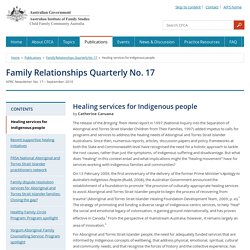
Since then, numerous reports, articles, discussion papers and policy frameworks at both the State and Commonwealth level have recognised the need for a holistic approach to tackle the root causes, rather than just the symptoms, of Indigenous suffering and disadvantage. But what does "healing" in this context entail and what implications might the "healing movement" have for services working with Indigenous families and communities? What is healing in the Indigenous context? According to the Macquarie Dictionary (Delbridge et al., 2005), to "heal" - derived from the Old English "hale" or "whole" - means to restore to health, to effect a cure, to make whole or sound.
Marumali. Lost Conversations - Finding new ways for black and white Australians to lead together. Download FREE now!
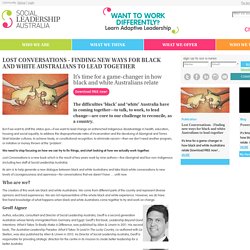
The difficulties ‘black’ and ‘white’ Australia have in coming together—to talk, to work, to lead change—are core to our challenge to reconcile, as a country. But if we want to shift the status quo—if we want to lead change on entrenched Indigenous disadvantage in health, education, housing and social equality; to address the disproportionate rates of incarceration and the devaluing of Aboriginal and Torres Strait Islander cultures; to achieve treaty, or constitutional recognition; to eliminate racism—then we don’t need another program, or initiative or money thrown at the ‘problem’. We need to stop focusing on how we can try to fix things, and start looking at how we actually work together. Lost Conversations is a new book which is the result of two years work by nine authors—five Aboriginal and four non-Indigenous (including two staff at Social Leadership Australia). Research.acer.edu.au/cgi/viewcontent.cgi?article=1098&context=research_conference.
Eprints.batchelor.edu.au/277/1/Farmer_%26_Fasoli_2011__You're_in_new_country.pdf. Traditional Dance. Department of Children and Families - Tune in to Little Ones. Tune in to Little Ones is a resource to help workers understand and notice the needs, strengths and vulnerabilities of infants under 2 years old (little ones) and their families.
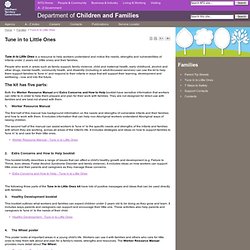
People who work in areas such as family support, family violence, child and maternal health, early childhood, alcohol and other drugs, mental health, community health, and disability (including in adult-focussed services) can use the kit to help them support families to 'tune in' and respond to their infants in ways that will support their learning, development and wellbeing - now and into the future. Both the Worker Resource Manual and Extra Concerns and How to Help booklet have sensitive information that workers can refer to in order to help them prepare and plan for their work with families. They are not designed for direct use with families and are best not shared with them. Italklibrary. Knowledge Circle. ECTA-MELINDA__MILLER_ARTICLE.pdf. Cross Cultural Issues – a practical approach to working with and managing Aboriginal employees in the work place.
Dave and Bess Nungarrayi Price – presented to the Aboriginal Employment and Training Summit, Milennium Hotel, Sydney 28 – 29 April, 1999.
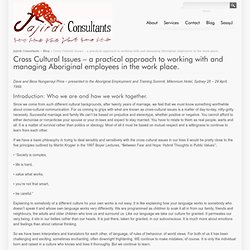
Since we come from such different cultural backgrounds, after twenty years of marriage, we feel that we must know something worthwhile about cross-cultural communication. For us coming to grips with what are known as cross-cultural issues is a matter of day-to-day, nitty-gritty necessity. Should non-Indigenous Australians be proud of Indigenous culture? All this month, I’ve had the pleasure of both contributing to, and reading, some of the great blogs that have made up the Deadly Bloggers Blogging Carnival as part of Australia’s Blak History Month.
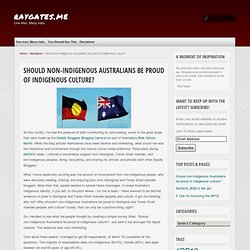
While the blog articles themselves have been diverse and interesting, what struck me was the interaction and involvement through the various social media platforms. Particularly during NAIDOC week, I noticed a tremendous support from Aboriginal, Torres Strait Islander, and non-Indigenous peoples, liking, favouriting, and sharing my articles and articles both other Deadly Bloggers.
What I found especially exciting was the amount of involvement from non-Indigenous people, who were obviously reading, sharing, and enjoying post from Aboriginal and Torres Strait Islander bloggers. So I decided to see what the people thought by creating a simple survey titled, “Should non-Indigenous Australians be proud of Indigenous culture?”
, and sent it out amongst the digital masses. A workplace guide. Understanding racism (1) Traditional perspectives. History. How do you feel creative response. What do you think reflective journal (1) What do you know quiz. What do you know quiz with answers. Aboriginal and Torres Strait Islander resource portal. Www.education.vic.gov.au/Documents/about/programs/aboriginal/Aboriginal Early Years Events Calendar.pdf. Kaurna Warra Pintyanthi. Kaurna Warra Pintyanthi. Similarities Between Aboriginal Culture and the Philosophy of Reggio Emilia. Gunawirra wants to thank Mark Rose for his wonderful contribution to our use of Reggio Emilia and our website. (25 July 2011 National Reggio Conference) The similarities between the Reggio Emilia Philosophy and Aboriginal Culture and Philosophy are immense.
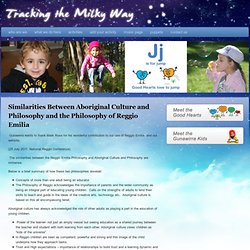
Below is a brief summary of how these two philosophies dovetail: Concepts of more than one adult being an educatorThe Philosophy of Reggio acknowledges the importance of parents and the wider community as being an integral part of educating young children. Calls on the strengths of adults to lend their skills to teach and guide in the ideas of the creative arts, technology etc. Aboriginal culture has always acknowledged the role of other adults as playing a part in the education of young children. Power of the learner- not just an empty vessel but seeing education as a shared journey between the teacher and student with both learning from each other.
Guidelines « Cultural practice resources « Resources « Cultural ways « Australian Indigenous HealthInfoNet. And Torres Strait Islander Peoples Engagement Toolkit 2012 (pdf).pdf. Kaurna Place Names : Welcome. Ses.library.usyd.edu.au/bitstream/2123/6913/1/RAL-chapter-4.pdf. The Little Red Yellow Black Website-an introduction to Indigenous Australia.
The Apology. YouTube. Snaicc.org.au/_uploads/rsfil/03202.pdf. Snaicc.org.au/_uploads/rsfil/02754.pdf. Www.community.nsw.gov.au/docswr/_assets/main/documents/working_with_aboriginal.pdf. The Marte Meo Method - Gunawirra. Marte Meo: Focus on the Child Currently used in ten Gunawirra preschools and in Miller Boomerangs Programme, Marte Meo is an internationally renowned program of over 20 years standing.
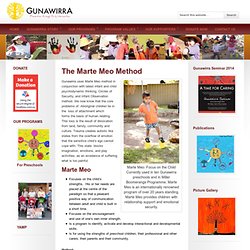
Marte Meo provides children with relationship support and emotional security. Gunawirra uses Marte Meo method in conjunction with latest infant and child psychodynamic thinking, Circles of Security, and Infant Observation method. We now know that the core problems of Aboriginal children lie in the loss of attachment which forms the basis of human relating. This loss is the result of dislocation from land, family, community and culture. Trauma creates autistic like states from the overflow of emotion that the sensitive child’s ego cannot cope with. Marte Meo Focuses on the child’s strengths. Method: Marte Meo programs are taken from natural developmental processes and from everyday life: Here are some comments from our professionals after our training in Marte Meo methodology: Healthy country, healthy people: the relationship between Indigenous health status and “caring for country” In Australia’s Northern Territory, 49% of the landmass and 85% of the coastline is owned by Indigenous peoples.1 More than 70% of the NT Indigenous population live on Indigenous land, predominantly in remote townships.2 Nationally, Indigenous life expectancy is well below the Australian average.3 In the NT, this lower life expectancy is underpinned by a disproportionate burden of disease linked to inactivity, malnutrition, social disorders and socioeconomic disadvantage.4 Type 2 diabetes and cardiovascular disease account for 40% of excess Indigenous mortality and over 21 800 preventable Indigenous hospital admissions annually.3 For Aboriginal and Torres Strait Islander peoples health does not just entail the freedom of the individual from sickness but requires support for healthy and interdependent relationships between families, communities, land, sea and spirit.

The focus must be on spiritual, cultural, emotional and social well-being as well as physical health.9 Methods. Www.snaicc.org.au/_uploads/rsfil/02932.pdf. Acknowledgement and Welcome to Country - What is it and why do we do it? Welcome to Country - Why is it important?
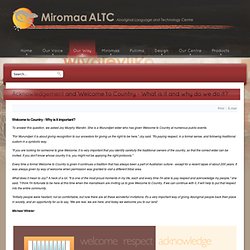
To answer this question, we asked Joy Murphy Wandin. She is a Wurundjeri elder who has given Welcome to Country at numerous public events. "For Wurundjeri it is about giving recognition to our ancestors for giving us the right to be here," Joy said. "It's paying respect, in a formal sense, and following traditional custom in a symbolic way. "If you are looking for someone to give Welcome, it is very important that you identify carefully the traditional owners of the country, so that the correct elder can be invited.
Every time a formal Welcome to Country is given it continues a tradition that has always been a part of Australian culture - except for a recent lapse of about 200 years. What does it mean to Joy? "Initially people were hesitant, not so comfortable, but now there are all these wonderful invitations. Michael Winkler. Similarities Between Aboriginal Culture and Philosophy and the Philosophy of Reggio Emilia. Www.noongar.org.au/images/pdf/forms/BookTwo-ProtocolGuide16p.pdf. Www.flinders.edu.au/staff-development-files/CDIP documents/CDIP Toolkit 2012/2_ Appropriate Terminology, Indigenous Australians.pdf. Www.ais.sa.edu.au/__files/f/132665/Reconciliation in Action - Indigenous Protocols.pdf. Www.communitybuilders.nsw.gov.au/TOOLKIT_-_FINAL_FINAL.pdf. Fmgl.com.au/UserDir/FMGReports/Documents/Fortescue Breakthrough Issue 07135.pdf.
Www.cmy.net.au/Assets/541/1/PearlsofWisdom-IndigenousAR.pdf. Sharing Culture - Empowering Aboriginal people to heal and develop resilience to historical trauma. Country Arts South Australia. Indigenous Reference Group Country Arts SA is committed to the continued development of its Indigenous program and in 2011 established an Indigenous Reference Group (IRG) to support the program.
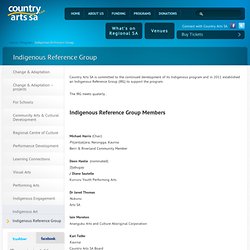
The IRG meets quaterly . Indigenous Reference Group Members Michael Harris (Chair) Pitjantjatjara, Narungga, Kaurna Berri & Riverland Community Member Deon Hastie (nominated) Djabugay. Www.ais.sa.edu.au/__files/f/132665/Reconciliation in Action - Indigenous Protocols.pdf. Welcomes. It is now commonplace for events to begin with a welcome to Kaurna land speech by a Kaurna Elder, often Kauwanu (Uncle) Lewis O’Brien or Ngarpadla (Auntie) Josie Agius, or sometimes by a younger person such as a student at Kaurna Plains School where Kaurna is taught. Whilst these speeches take a variety of forms, a minimalist Kaurna speech is reproduced here in order to familiarise people with a few of the common elements within these speeches.
Protocol and Guidelines Adelaide City Council Protocol and Guidelines on ‘Welcome to Country’ and ‘Acknowledgement of Country’ provides an effective model for communication together with the Aboriginal and Torres Strait Islander peoples. The comprehensive document describes how to formally engage with the Kaurna community. Www.bp.com/liveassets/bp_internet/australia/corporate_australia/STAGING/local_assets/downloads_pdfs/Protocol_for_WelcometoCountry_Final.pdf. Www.noongar.org.au/images/pdf/forms/BookTwo-ProtocolGuide16p.pdf. Welcome to Country & Acknowledgement of Country. If you participated in an activity that involved Aboriginal people you might have experienced a Welcome to Country or Acknowledgement of Country. Both are protocols that precede the activity. They recognise the unique position of Aboriginal people in Australian culture and history and show respect for Aboriginal people.
If you are planning to include a ‘Welcome to Country’ or do an ‘Acknowledgement of Country’ make sure to consult with Aboriginal people of the community where the event takes place. This way you ensure that the ceremony pays the appropriate level of recognition and involves the right people. Www.flinders.edu.au/staff-development-files/CDIP documents/CDIP Toolkit 2012/2_ Appropriate Terminology, Indigenous Australians.pdf. Www.newscholar.org.au/index.php/ns/article/viewFile/71/54. Fwtdp.org.au/wp-content/uploads/2014/02/FWT+DP-RAP-Resource-List-Dec-2013.pdf. Aboriginal Early Childhood Support and Learning Incorporated. Apology Day 2014. Www.snaicc.org.au/_uploads/rsfil/03265.pdf. Sharing Culture - Home. Connections and disconnections… thoughts on Aboriginal cultures in early childhood services. I went camping over the Christmas holidays. I always do. There is this place that I have camped at every year of my life. My parents took me there as a baby, a child and a teenager.
As I got older, I took my own friends there. One day I will take my own children there. This place is special to me. I always spend at least half of every day there just watching the river, watching the trees. Sleep on country. Illustration: Michael Leunig Australian identity? Who knows. Who cares? And does it matter that such a complex and elusive concept about nationhood be enshrined in words? Attempts to do so are often lopsided and frequently received with a shrug or a wry groan. Yet there is a nation of individuals who occupy a common ground – of which they are custodians, whether they realise it or not. Yet all too easily a nation that is predominantly urban in character may lose sight of its natural setting and spirit of country – and be all the poorer, sadder and less vital for such loss of connection; it may suffer some deadening loss of imagination, joyous humility and visionary innocence. A white tourist from the South was heard to ask an old indigenous man in Northern Queensland how best she might get to understand and connect to the country in the way that he did.
Share Our Pride. Kaurna Warra Pintyanthi. Poster Gallery. Library. Creative Spirits - Aboriginal Australia, Photography and Poems. Now Available for Free Download: Being Black Is Not a Risk Factor. The National Black Child Development Institute (NBCDI) is excited to share our newest publication! From the foreword by Barbara Bowman of the Erikson Institute to a closing essay by David Johns, Executive Director of the White House Initiative on Educational Excellence for African-Americans, Being Black Is Not a Risk Factor: A Strengths-Based Look at the State of the Black Child is designed to challenge the prevailing discourse about Black children–one which overemphasizes limitations and deficits and does not draw upon the considerable strengths, assets and resilience demonstrated by our children, families and communities. This report, which addresses the needs of policymakers, advocates, principals, teachers, parents and others, weaves together three critical elements: Our outstanding essay contributors, in addition to Barbara Bowman and David Johns, include: Cecilia Alvarado, University of the District of Columbia Community CollegeA.
Www.unicef.org.au/downloads/Education/Photo-stories/What-I-See. Stronger Smarter Institute. City of Charles Sturt - Kaurna Meyunna ‘Kaurna People’ Marni na budni, Kaurna meyunna yertangga Greetings to the Country of the Kaurna people. Creative Spirits - Aboriginal Australia, Photography and Poems. Www.snaicc.org.au/_uploads/rsfil/02902.pdf. Www.snaicc.org.au/_uploads/rsfil/03193.pdf. 'Girls can't be Batman!': Gender, Aboriginality and multiculturalism in early childhood education. 'Girls can't be Batman! ': Gender, Aboriginality and multiculturalism in early childhood education There are many forms of 'unfinished business' in the politics of early childhood education.
Activity Chart for Multiple Intelligences Boandik People and their .._1_ Reconciliation Australia It's Time - The Apology. What Works, the Work Program. A children's book of Aboriginal Stories. Pridmore, S (2012) A Children's Book of Aboriginal Stories. Working in remote communities Certificate III Children's service in Northern Territory Australia. I was asked to write an article for the Kindergarten Parents Victoria Magazine. They have also invited me to present this work at the KPV conference on the 1st of June 2012 in Melbourne. Growing up our way. Growing up our way practices matrix. The Little Red Yellow Black Website. Critical race and whiteness studies. Editor. Rights of Indigenous Australians. Why Only One in Three? The Complex Reasons for Low Indigenous School Retention - CAEPR - ANU.
Australia apology to Aborigines put to song. Healing Foundation. The Story of the Healing Foundation. Culture, Play, Children's Rights and Ethics. Look After Kids Ears - Home. Sick ears can cause hearing loss in little kids. Early Learning Programs. Indigenous children and behaviour management strategies. Indigenous.gov.au » Early childhood.
Ways of Knowing, Being and Doing. Argue that the quantity of research conducted in Aboriginal lands and on Aboriginal people since British invasion in the late 1770s is so immense that it makes us one of the most researched groups of people on earth. Natural scientists such as biologists, geologists and botanists have conducted research on Aboriginal lands to identify potential resources and, thus, economic value. Learning country through our eyes - Dave Johnston › Meet a Scientist (ABC Science) Text of PM Rudd's 'sorry' address - National - theage.com.au. National Aboriginal and Islander Children's Day. Aboriginal Family Support Services.